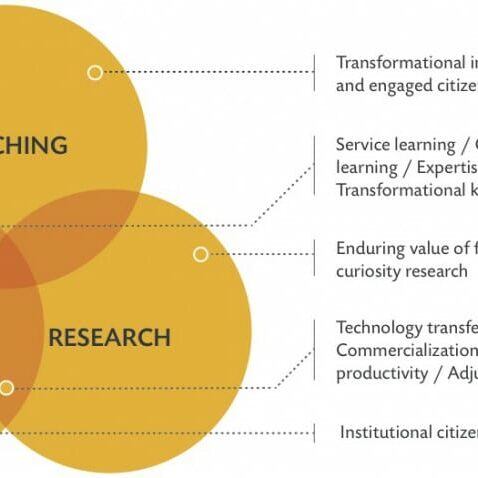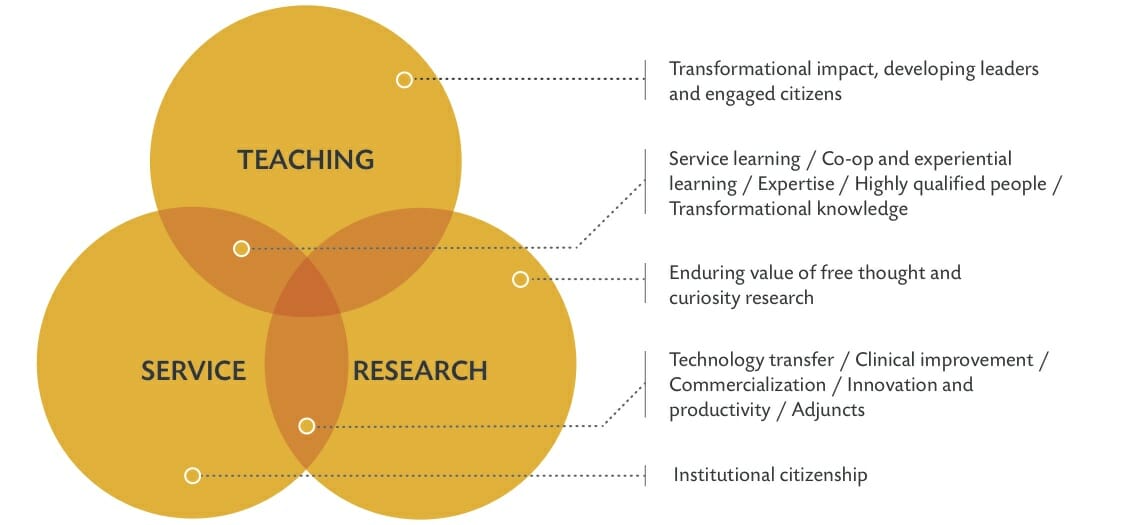

Florizone splits Dal’s role into three categories to better address each. (Infographic via 100 Days of Listening report)
Richard Florizone held 48 group consultations, 554 smaller meetings and received 766 online submissions during his first 100 days at work. His report, 197 pages long, was released on Dec. 23, cutting it close to the deadline and over double the anticipated length.
Clearly six very busy months wasn’t enough to dent the new president’s enthusiasm.
The good news is that there isn’t much bad news, not that it was expected. The university has debt, which was known, and no clear way to eliminate it, which comes as no surprise.
Nova Scotian universities are already at a disadvantage since provincial funding has taken a nosedive. In 1992-93, the province contributed 74 per cent of operating revenue; in 2012-13, it covered only 54 per cent.
“Nova Scotia’s provincial operating funding per student is now among the lowest in the country, although operating funding per capita is third highest,” says the report.
One thing said without as many words in the report: this will not last.
*******
In 2018, Dalhousie will turn 200. It’s starting to show.
According to the report, Dal’s five campuses house 146 buildings over 5.4 million square feet. Of that, 76 per cent of the space is 25 years old or older and described as “at risk of failure.” While the report admits the vote is pretty much split whether Dal needs new buildings, “given the age of our buildings and our deferred maintenance backlog, the reality is that Dalhousie must continue to invest significantly in its physical infrastructure.”
In the U15 index, a report of 15 equally sized universities to compare development, Dal has the second most aged campus. Sexton campus, in particular, is long overdue for an overhaul.
The need for increased and improved space has become more apparent over the past decade, as the student population grew approximately 24 per cent between 2002 and 2012. A large portion of this growth has been international students, up from 809 in 2000 to 2,686 in 2013.
But all is not well for Dal’s relationship with international students. One of the only blatant problems repeated in the report was student retention, in particular first year students and especially international students. Retention rates at Dal are seven to eight points below the U15 average, showing a problem primarily among international students.
“We should not be encouraging international students to come here if we cannot deliver on what we promise them,” said a staff member anonymously in the report.
“I’ve seen so many of them struggling.”
Approximately 14.5 per cent of the student population of Dalhousie is international students, with students coming from over 100 different countries. While Canada is now receiving over 100,000 international students annually, the report suggests that Dal needs to figure out how to get a bigger chunk of that number, and beyond that, maintain the influx after first year.
University programs were another point brought up. Dal has more undergraduate programs per student than any other U15 university, and in 2010, 24 per cent of undergraduate major programs accounted for 80 per cent of undergraduate enrolment. The question is whether this is good or bad.
The report did make a tangible recommendation: “We propose a process of Faculty-led program review, engaging Senate for input and approval, and with some central coordination to develop overall principles and practices and to monitor and learn from similar efforts at other universities.”
Student finances, however, didn’t get the same treatment. First brought up on page 57, it only went as far as explaining the differences between entrance scholarships, in-course scholarships and bursaries. It did not offer any resolutions or promises for review, or even mention that students are unhappy with the cost of their education for another 60 pages.
Tuition and provincial funding continue to represent over 90 per cent of all university revenue. As provincial funding has decreased, approximately $11.2M just since 2011, tuition has raised to make up the difference. Today tuition is 36 per cent of all revenue, twice as high as it was in 1992-93. It’s not surprising then to read that Dalhousie has some of the highest tuition fees across the country.
The report includes a silver lining to the university’s finances. If Dal were to go into debt in order to complete all of the major capital projects currently being considered all at once, the university would still only have the third highest debt in the U15.
The report covered more than student services, going into detail on workplace environment and the financial aspects of expanding infrastructure, among other things.






